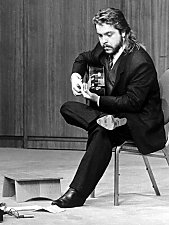Raphael Rabello
| Raphael Rabello | |
|---|---|
 |
|
| Background information | |
| Birth name | Raphael Baptista Rabello |
| Born |
October 31, 1962 Petrópolis, Rio de Janeiro, Brazil |
| Died | April 27, 1995 (aged 32) Rio de Janeiro |
| Genres | Bossa nova, choro, world music |
| Occupation(s) | Musician |
| Instruments | Classical guitar |
| Years active | 1974–1995 |
| Labels | Polygram, Barclay, Visom, Columbia, Caju, RCA, Chesky, RGE, Spotlight, Acari, GSP |
| Associated acts | Os Carioquinhas, Camerata Carioca |
Rafael Baptista Rabello (October 31, 1962 – April 27, 1995), was a virtuoso Brazilian guitarist and composer. During the 1980s and 1990s, he was considered one of the best acoustic guitar players in the world and played with many famous artists, such as Tom Jobim, Ney Matogrosso, Paulo Moura, and Paco de Lucia.
Raphael Rabello was born in Petrópolis, Rio de Janeiro, Brazil. He was the youngest child of his family, which included many musicians. His sister Luciana was a well-known cavaquinho player and his other sister, Amélia, became a singer. His first guitar teacher was an older brother, Ruy Fabiano, when Raphael Rabello was seven years old. However, the biggest influence on Rabello starting his music studies was his grandfather, José de Queiroz Baptista, who was a choro guitar player.
He studied music theory with Maria Alice Salles, who also taught his brothers and sisters. In the 1970s, he took guitar lessons with Jaime Florence, the famous Meira, who had also taught Baden Powell in the 1940s. In the same period, he studied harmony with Ian Guest. Influenced by Dino 7 Cordas, Rabello eventually switched to the Brazilian seven-string guitar and started playing professionally when he was a teenager.
His first recording as a sideman was at age 14 on a recording of choro music by classical guitarist Turibio Santos. In this period, he took lessons from guitarist Dino 7 Cordas (Dino 7 strings), with whom he recorded an LP in 1991.
In 1976, he founded the group Os Carioquinhas, with his sister Luciana Rabello (cavaquinho), Paulo Alves (mandolin), Téo (acoustic guitar) and Mario Florêncio (tambourine). The band became famous and played with many other choro groups, such as Época de Ouro and Quinteto Villa-Lobos. They also recorded one album in 1977.
...
Wikipedia
